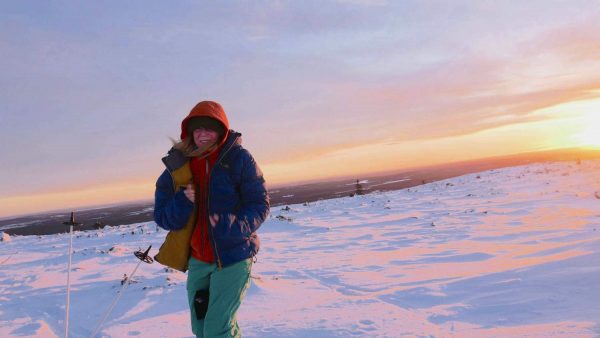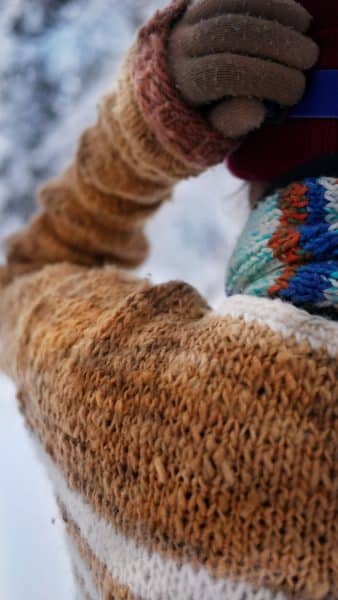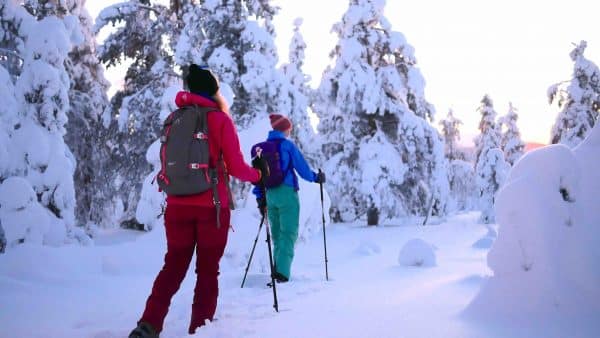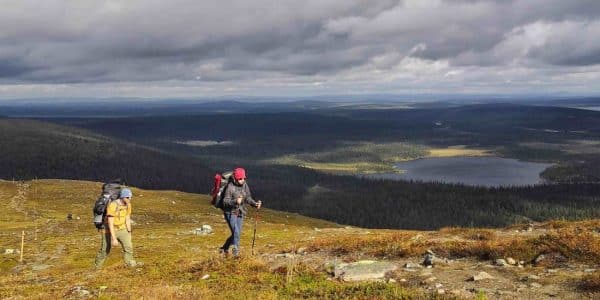Is the magical winter wonderland of Lapland with reindeers and northern lights on your bucket list? But perhaps you are not sure about the extreme cold weather and how to survive alive? Firstly, have mercy on yourself, it takes a couple of weeks for the body to get used to the cold, so it does feel harsher for you than for us living here. Secondly, worry not and keep reading! Here are some tips of what to consider before packing for a winter holiday. Some of the stuff you can rent, like shoes and overalls, so no need to buy everything.
1. Base Layer: Wool, Wool and Wool
Based on our experience, the best material for keeping you warm in all situations is wool. You need a long-sleeved top and long bottoms and you wear them fairly tightly against the skin. We like Aklima, Devold, Mons Royale and Kari Traa. You can find ethically produced (mulesing free) and good quality merino wool, which doesn’t itch. To be honest, on our longer hikes we don’t even change the base layer – we sleep in it, sweat in it, hang out in it… The thing is, wool will keep you warm even when it’s moist. Cotton doesn’t. Synthetic materials such as polyester doesn’t. Wool dries quickly and doesn’t stink. Total winner! Basically we wear woollen clothes year-round. Also, socks should be wool. Cotton socks are the worst: if your feet get moist during snowshoeing or skiing, the socks will remain wet and make your toes freeze. If you find a woollen bra and underpants as well, you are good to go anywhere! Some people like bamboo so that might be an option, too.
2. Middle Layer for Trapping Air
The point of the middle layer(s) is to give you extra warmth. Add as many layers as needed – and control your comfort temperature by taking some layers off or on. In winter, we try to avoid sweating, as moisture is what will make you shiver when the body cools down. Often it’s impossible though, I myself sweat very easily… If not doing sweaty stuff then thick cotton is fine, like a flannel shirt. When doing some sweatier sports the point of the middle layer is also to pass moisture on from the base layer. Then the cotton isn’t great. Optimal fabric for the middle layer is one that traps air efficiently. After all, insulating air is the magic that keeps you warm. Fleece, wool or even airily knitted acrylic fabrics work. I myself prefer natural fibers that last for ages, so again I wear mostly woollen knits as mid-layer.
However, all of the above have their ethical issues: polyester-made-fleece releases microplastics into the environment when washed. Same with plastic-based acrylics. Very problematic for all life forms. If you wear them, you should wash them as seldom as possible. Also, acrylic fabrics are often not of great quality so their lifespan is short. Wool is great, but how can you tell if the sheep are really treated well?
3. Top Layer – Jacket and Pants for Protection
One perfect winter jacket doesn’t exist, I’m afraid. You can spend lots of money on a super warm Canada Goose parka, but if you intend to do anything else but sit on a husky sled or stand still, you’ll be roasted. If you are moving with snowshoes, skis or fatbike, your body will create heat even in our cold temperatures of -20 or -30 Celsius (which are pretty normal temperatures here, especially in December and January). So we actually wear different jackets for standing around and for playing around. For all the snow activities we wear a thin jacket, made of cotton or cotton-polyester mix like they do at Sasta and Fjällräven. Often it’s the very same jacket we wear in summer! The cotton-polyester fabrics breathe, protect from wind and stand time. You add extra moisture protection by waxing the jacket with beeswax.
The point of the outer layer is to protect all the other layers from the weather. There just has to be some space for the middle layer and air. A Gore-Tex jacket is good for mountains where you really need to keep wind and moisture outside. But it doesn’t breathe and thus will be sweaty. At least for me, it’s too sweaty. So pack any sort of windproof jacket, which has room for layers. For standing around you can rent warm overalls from most villages.

But wait – you do need a warmer jacket to wear when the movement stops! It gets chilly very quickly. We always carry down jackets in our rucksacks to wear on breaks (for ourselves and for our customers). Down can be squeezed in very small space and yet is super warm. Get a down jacket that is bigger than your normal jackets, so you can wear it on top of everything. I’m normally about size M but wear a down jacket size L or XL. If buying a new one, make sure it’s certified by the Responsible Down Standard! Our down jackets are from Rab.
For pants, take the warmest ones you have. You rarely sweat from your thighs on normal winter outings, so I think pants can be thicker than the jacket. Jeans aren’t great for moving about in the snow, but softshells, hard shells or pants with synthetic or down pads will work. I personally get a cold bottom easily, so I tend to wear woollen shorts on top of my merino wool long johns, and softshells/hardshells as an outer layer.
“Rule number one is: pick winter shoes at least one size up from your normal size. “
4. Shoes – It’s Not About the Looks
Winter boots that actually keep your toes warm are rarely super pretty. The most common mistake is to come here in a) normal sneakers or b) in good-looking and well-fitting wannabe-winter-boots. You will first feel the cold in your toes and fingers, so shoes are very important. Rule number one is: pick winter shoes at least one size up from your normal size. You need air inside the shoe for insulation, and therefore well-fitting shoes will mean freezing toes. Also, you need space for extra layers of socks. Woollen socks are the best. The thick sole is a plus as the cold creeps in through there. So good warm winter boots look and feel a bit clumsy, but they do the job. I personally keep my toes warm in big Sorel Caribous with two woollen socks. Felt boots are also great (mine are Nesnalobben). Felts are made of wool and are pretty traditional in this corner of the world – they are fantastic on a really cold day as wool insulates well and lets moisture out of the shoe. Plus they are very pretty! But they don’t take hardcore rubbing well, so felt boots are not the best option, for instance, for snowshoe bindings.
5. Gloves or Mittens?
Some people get cold fingers and toes very easily, some don’t. Depends on how good your circulation is. Mine is crap. The only way is to try what works for you. Overall, mittens do keep your fingers warmer than gloves. In gloves, each finger is isolated while in mitts they stick together, warming each other. You can also wear them both at the same time, that’s my solution and it works: In winter I pretty much always wear thin well-fitting liner gloves, made of merino wool. With these, I can operate my camera or dig out a tissue from my pocket, without exposing naked skin. On top of the liner gloves I wear big mittens, so there is air inside for insulation. I’ve had Hestra leather box mitts for years. There’s a removable liner that I’ve changed once (it does suffer from wear and tear), and the outside leather I take care of by waxing. Leather is good as it protects from moisture and can take the heat from open fire better than synthetics.
6. Keep Your Phone Alive!
Mobile phones die easily in cold weather – especially iPhones are famously crap in cold environments (really, they die within minutes). To prevent the battery from emptying, put your phone somewhere near your warm body. Get a phone cover that you can wear around your neck, on top of the base layer to keep it warm. Or put it in a waist bag and tuck it under your jacket. Often the side pockets of jackets and pants are too cold, so trust me, this is really something worth considering.
Minttu
Wilderness guide and co-owner of Pihka Outdoors. Sweats easily and freezes quickly – yet enjoys living in Ylläs, Finnish Lapland with proper gear.





